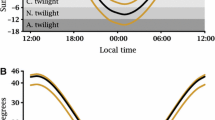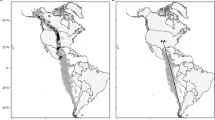Abstract
Our theme is “Evolution of escape,” by contrasted strategies of migration and of diapause. Migration is characterized not only by escape from adverse conditions, but also by the active exploitation of temporary habitats — as Southwood (19 62) has emphasized. We now know that far back in geological time (and long before the first birds) there were already wind systems available of a kind likely to have enabled the early insects to locate and exploit new food supplies following rains — as Desert Locusts (Schistocerca gregaria Forsk.) can so spectacularly do to this day. Thus the extent and consistency of orientation of fossil sand dunes in the western United States provide evidence of prevailing easterly tradewinds in Permo-Carboniferous times, with the dunes, by continental drift, then in appropriately lower latitudes than their present position (Runcorn, 1961).
Access this chapter
Tax calculation will be finalised at checkout
Purchases are for personal use only
Preview
Unable to display preview. Download preview PDF.
Similar content being viewed by others
References
Bowden, J., Gibbs, D.G.: Light-trap and suction-trap catches of insects in the northern Gezira, Sudan, in the season of southward movement of the Inter-Tropical Front. Bull. Ent. Res. 62, 571–596 (1973).
Godfrey, W.E.: The birds of Canada. Bull. Natn. Mus. Can. (Biol.) 73 (1966), 428 pp.
Gregory, P.H.: The Microbiology of the Atmosphere. Plant Science Monographs: Leonard Hill London/Interscience New York (1961).
Rainey, R.C.: Weather and the movements of locust swarms: a new hypothesis. Nature, Lond. 168, 1057–1060 (1951).
Rainey, R.C.: Meterology and the migration of Desert Locusts: applications of synoptic meteorology in locust control. Tech. Notes World Met. Org. 54 (1963); 115 pp. (also as Anti-Locust Mem. 7).
Rainey, R.C.: The origin of insect flight: some implications of recent findings from palaeoclimatology and locust migration. 12th Int. Congr. Ent., London, 134 (1965).
Rainey, R.C.: Effects of atmospheric conditions on insect movements. Quart. J. Roy. Met. Soc. 95, 424–434 (1969).
Rainey, R.C.: Airborne pests and the atmospheric environment. Weather, Lond. 28, 224–239 (1973).
Rainey, R.C.: Biometeorology and insect flight: some aspects of energy exchange. Ann. Rev. Ent. 19, 407–439 (1974).
Rainey, R.C.: Flying insects as ultra-low-volume spray targets. Br. Crop Prot. Counc. Monogr. 11, 20–28 (1974a).
Rainey, R.C.: New prospects for the use of aircraft in the control of flying insects and in the development of semi-arid regions. 5th Int. Agric. Aviat. Congr., Kenilworth, 229–233 (1975).
Rainey, R.C.: Flight behaviour and features of the atmospheric environment. Symp. R. Ent. Soc. Lond. 7, 75–112 and 272–273 (1976).
Rainey, R.C.: Rainfall: scarce resource in “opportunity country.” Phil. Trans. R. Soc. (B) 278, 439–455 (1977).
Rainey, R.C., Joyce, R.J.V.: The use of airborne Doppler equipment in monitoring wind-fields for airborne insects. 7th Int. Aerospace Instrum. Symp. Cranfield 8.1–8.4 (1972).
Runcorn, S.K.: Climatic change through geological time in the light of the palaeo-magnetic evidence for polar wandering and continental drift. Quart. J. Roy. Met. -Soc. 87, 282–313 (1961).
Schaefer, G.W.S.: Radar observations of insect flight. Symp. R. Ent. Soc. Lond. 7, 157–197 (1976).
Southwood, T.R.E.: Migration of terrestrial arthropods in relation to habitat. Biol. Rev. 37, 171–214 (1962).
Urquhart, F.A.: The Monarch butterfly. University of Toronto Press (1960). Waloff, Z.: Orientation of flying locusts (Schistocerca gregaria Forsk.) in migrating swarms. Bull. Ent. Res. 62, 1–72 (1972).
Weis-Fogh, T.: Energetics and aerodynamics of flapping flight: a synthesis. Symp. R. Ent. Soc. Lond. 7, 48–72 (1976).
Wigglesworth, V.B.: The origin of flight in insects. Proc. R. Ent. Soc. Lond. (C) 28, 23–32 (1963).
Wigglesworth, V.B.: The evolution of insect flight. Symp. R. Ent. Soc. Lond. 7, 255–273 (1976).
Editor information
Editors and Affiliations
Rights and permissions
Copyright information
© 1978 Springer-Verlag New York Inc.
About this paper
Cite this paper
Rainey, R.C. (1978). The Evolution and Ecology of Flight: the “Oceanographic” Approach. In: Dingle, H. (eds) Evolution of Insect Migration and Diapause. Proceedings in Life Sciences. Springer, New York, NY. https://doi.org/10.1007/978-1-4615-6941-1_2
Download citation
DOI: https://doi.org/10.1007/978-1-4615-6941-1_2
Publisher Name: Springer, New York, NY
Print ISBN: 978-1-4615-6943-5
Online ISBN: 978-1-4615-6941-1
eBook Packages: Springer Book Archive




